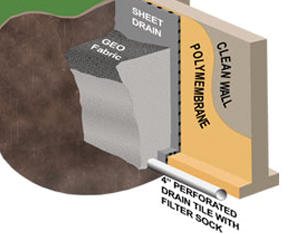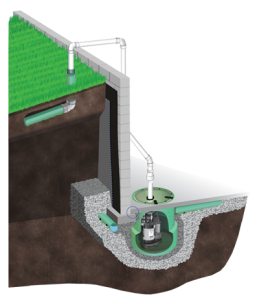Exterior vs. Interior Basement Waterproofing: Which One Is Best?
Your home is usually your biggest investment, so keeping it in good condition is likely a top priority. Cosmetic up upkeep like paint or flooring is easy to keep track of because you can see it on a regular basis. But how often do you think about keeping your basement dry? In an area where it both rains and snows, waterproofing your basement should be on the top of your list. Now the question is which solution works best, exterior or interior basement waterproofing?
Exterior Waterproofing

Exterior Drainage System
Exterior waterproofing protects your home from water from the outside. It acts as your first line of defense before the water can even make it into your basement. Exterior solutions include:
- Gutters & Downspouts: Always make sure your gutters are clean so they can effectively lead water away from your foundation.
- Proper Grading: Proper grading will ensure that water flows away from your home when it rains instead of towards it.
- Exterior Drainage System: Rapid Foundation Repair prides itself on using Earth Contact Products to install an effective exterior drainage system that includes a polymer waterproofing coating to keep moisture out of the concrete, a dimple board to protect the coating, and a drain pipe system to continuously drain water away from the foundation.
These waterproofing solutions can be more expensive due to the need for excavation, but they pay off in the long run. A good exterior waterproofing system can keep water out more permanently than a watered-down damp-proofing solution. This eliminates the worry that your foundation will weaken over time due to excess moisture.
Interior Waterproofing
Interior waterproofing protects your home from water damage from the inside. It makes sure water that does make it into the basement is drained out of the house and away from the foundation. There are a few key elements to interior waterproofing:

Interior Drainage System
- Vapor Barriers: Vapor barriers are usually foil or plastic wall coverings installed to keep moisture away from the concrete. They can help lead moisture to a drainage system.
- Interior Drainage System: A perforated drain pipe, which is installed inside the perimeter of the footing, is the most effective interior drainage system.
- Sump Pump: Water drawn through the drain pipe goes into a sump basin, a pit beneath your basement floor. The sump pump then pumps the water out and away from the home.
Interior basement waterproofing is usually easier to install and less costly than an exterior solution. An investment in a good interior waterproofing system can protect your home from flooding and other risks of water damage, like mold and mildew.
Which Type Is Best?
Which type of waterproofing solution is best? In a word, both. Each type of waterproofing has pros and cons. Interior waterproofing doesn’t keep water from getting into your basement, and exterior waterproofing can be expensive. However, both of them, especially if they are working together, have ways of protecting your home from water damage and keeping your home in good shape.
Rapid Foundation Repair offers both exterior and interior waterproofing solutions. Whether you decide that one is better for you than another or that both will serve you best, we can help you from start to finish. Contact us today for a free quote!
